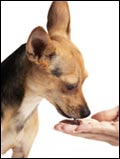Treats for Training your Dog

Dog training is an important part of dog ownership and when done properly, it sets the stage for a fabulous relationship between you and your dog. Dogs learn that when they perform certain tasks or AVOID certain behaviors, they get treats. This also teaches them who is the boss or the leader of the pack (and it should always be the owner and his/her family). This needs to be clear in the dog’s mind because if it is not clear, some dogs may challenge their human family by exhibiting “dominant” behaviours like growling at them. By actively training your dog to do tasks and listen to you, you further reinforce your role as the leader. Dogs that clearly know who the leader is are normally happier and calmer because they no longer have to worry about all the decisions that leaders need to make.
Since so many dogs are motivated by food, food treats are probably the best reward to start off with when trying to train your dog and dog trainer Sherry Bedard offers up a few tips on which dog treats may be best and which to avoid.
“When it comes to the best treats for dogs for training, your dog will tell you. Dogs are like people and they don’t all like the same things. A good piece of advice would be to try out different treats and see what works best for your dog. While some dogs would prefer hot dogs others might prefer dried liver treats or beggin strips. It is highly recommended that owners refrain from giving their dogs dairy foods. Dairy foods can often cause health problems. Chicken is one of the meats that is most often problematic for dogs and often causes slight allergies such as dry skin and dogs being more prone to skin lesions and infection.
When relaxing and just hanging around with your dog, it is not recommended that you give treats to your dog if the dog has not been asked to perform a specific task. Dogs are often prone to obesity when owners don’t give their dog enough exercise and give too much food and extra treats. Although many people think the contrary, it is normal to see the last ribs of your dog! If you don’t see them, your dog may be over weight. If your dog has a little belly (meaning when the dog is standing, looking at his belly, the dog’s stomach is level or almost level with his ribcage) or looking at your dog from the top, his body is straight (he has no curves, his belly is in a stright line or curves outward from his ribs to his hips), he is obese. Dogs that are over weight are not healthy and are prone to developing many diseases not to mention living a lower quality of life. For more advice on your dog’s ideal weight, please ask your veterinarian.
Using treats to help you train your dog is an effective method but care must be taken not to overdo the treats. For a large dog, each treat given for a command should be no larger than the size of a 10 cent coin. For a small dog, the treat should be no larger than a small pea.
Two of the most effective methods of using treats for training are to make sure your dog is hungry so the treats will be most effective, and make sure your dog can concentrate on the task at hand by getting him to get out all of his excess energy before beginning to teach him something that will require him to concentrate.”
Sherry Bedard is the author of Sherry’s Secret Dictionary, A Guide to Your Dog. She is an animal behaviourist and trainer working in Montreal. She founded Animal instincts school in 2005 and she teaches people how to become dog trainers and consults on a 1-to-1 basis with dog owners that are having problems with their dog. Sherry also teaches canine and feline behavior to students in the adult education program at Vanier College and regularly volunteers her time and expertise at local animal shelters in Montreal. Recently, Sherry started a dog club called Power Paws Dog Club which offers free training in canine pulling sports.
